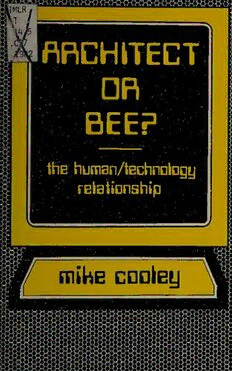
Architect or Bee?: The Human / Technology Relationship PDF
Preview Architect or Bee?: The Human / Technology Relationship
ARCHITECT * 2 □R ; ■a fi I I u «« B 't! KSil »: mike coaiey |1 [l m ci l« Architect Or Bee? Architect Or Bee? THE HUMAN/TECHNOLOGY RELATIONSHIP by Mike Cooley Introduction by David Noble Compiled and edited by Shirley Cooley SOUTH END PRESS BOSTON, MA © 1980 by Hand and Brain Publications. All rights reserved. No part of this publication may be reproduced, stored in a retrieval system or transmitted in any form or by any means, without the prior permission of Hand and Brain Publications, 95, Sussex Place, Slough, SL1 INN, England. First published in the U.S.A. in 1982 by South End Press. ISBN 0-89608-131-1 Cover design by Lydia Sargent Second Printing Typeset, paste up and design by the collective at South End Press 302 Columbus Ave Boston, MA 02116 TABLE OF CONTENTS Editor’s Preface vii Introduction by David Noble xi 1. Identifying the Problem 1 2. The Human Machine Interaction 25 3. Political Implications of New Technology 51 4. Drawing Up the Corporate Plan at Lucas Aerospace 81 5. Some Social and Technological Projections 107 Editor’s Preface It is only recently that the social problems arising from technological change have become the subject of widespread public concern. The predictions that Mike made in his lectures in 1960-70 and thereafter, and in his 1972 book Computer Aided Design—Its Nature and Implications are now becoming a reality, and the trade union movement is beginning to recog¬ nize that the nature of the new technology is an important and fundamental issue requiring urgent action. The question some are now asking is whether the horse has already bolted and the technology advanced so far along the wrong path that it is too late to divert it along a different one. This however is not the author’s view, or that of the Lucas Aerospace Combine Shop Stewards’ Committee which is cur¬ rently working with other combines, researchers in the field and the Centre for Alternatives Industrial and Technological Systems (CAITS) to produce corporate plans around socially useful products and human centered technologies. The tech¬ nologies being evolved are those which will again link hand Vll Vlll ARCHITECT OR BEE and brain in the productive process and which will enhance the creativity of the producer. The book is basically a collection of material extracted from the very wide range of articles, papers, lectures and addresses at trade union meetings which Mike has produced over the last eight years. His work is based on over 20 years experience as an industrial designer in factories where he has felt the impact of new technology on his own job and that of his fellow workers. His analysis has progressed from the use/abuse model evident in his earlier work, to encompass the idea that a society’s technology is an integral part of its politics, and that present technological systems are used for purposes of political control by the multinational companies. He uses the computer as a sort of political aperture through which to view the prob¬ lems advanced technology as a whole is bringing with it. If a society is to be a truly democratic one Mike says, it will have to develop radically different technological systems. The reader will note that there is an inevitable imbalance in the style and presentation of the material which requires perhaps some explanation. Some parts are closely argued and fully referenced while others are sharp, somewhat rhetorical and not referenced at all. The former material is taken from lectures and papers presented to academic bodies and scientific societies and were produced in the written form in the first place. The sparsely referenced material comes from talks and discussions that were later written up or published in maga¬ zines and journals. These include the explanations of the ideas behind the Corporate Plan and the details of some of the products which were the subject of countless meetings within the trade union movement over several years. In spite of the variation in style, the book stands as a whole in the sense that it is a progression of ideas. It begins by giving the reader an outline of the nature of technological develop¬ ment in industry. It then goes on to demonstrate the effects all this is having on the individuals who are involved with it, those who are displaced by it, and on the society as a whole. It examines the implications of extracting skills from people and programming the fragmented parts into machines and the implications of nuclear power and control by the equipment
